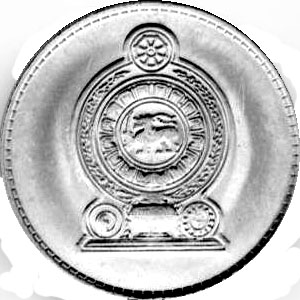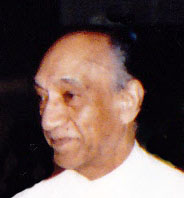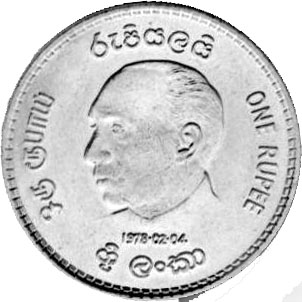| SPECIFICATIONS | |
| Denomination | Rupees One |
| Alloy | cupro-nickel |
| Diameter | 25.4 mm |
| Weight | 7.13 gms |
| Thickness | 1.9 mm |
| Shape | Round |
| Edge | Security 1 |
| Die-Axis | 0° |
| Special Die | 2,600 |
| Mint | Royal,Wales |





|

|

| ||||||||||||||||||||||
| KM# 144 | ||||||||||||||||||||||||
Obverse : The Armorial Ensign of Sri Lanka within circle of dashes along periphery with raised rim.
Reverse : An proile image of the President His Excellency J. R. Jayewardene facing left in the center
with the date 1978.02.04 of inaugaration below.
රුපියලයි
in Sinhala, on top, and
ஒரு ரூபாய்
in Thamil on left, and ONE RUPEE on right. The country name
ශ්රී ලංකා
(Sri Lanka) in Sinhala only, centered at bottom. All within circle of dashes along periphery with raised rim.
 It will be interesting to note that the minting of this coin was
undertaken at very short notice, in fact a matter of only three weeks
was available for the designing, preparation of tools, minting of the
coins and delivery of at least a small quantity for issue on the
appointed date. To circumvent these difficulties the Royal Mint
adopted a special tool method. This consignment was brought to Sri
Lanka in the early hours of 1st February 1978 by T. M. U. Sallay
(Senior Assistant Superintendent of Currency and author of book "Sri
Lanka Currency of Recent Times 1938-1985") who had been flown earlier
to London in this connection.
More...
The effigy on these 2600 special coins is
slightly different from those on the balance of the order.
The most noticeable difference is the shoulder line of the President's
image. In this rare coin shown above it is comparatively straight, while
in the standard coin shown on right it curves upwards.
It will be interesting to note that the minting of this coin was
undertaken at very short notice, in fact a matter of only three weeks
was available for the designing, preparation of tools, minting of the
coins and delivery of at least a small quantity for issue on the
appointed date. To circumvent these difficulties the Royal Mint
adopted a special tool method. This consignment was brought to Sri
Lanka in the early hours of 1st February 1978 by T. M. U. Sallay
(Senior Assistant Superintendent of Currency and author of book "Sri
Lanka Currency of Recent Times 1938-1985") who had been flown earlier
to London in this connection.
More...
The effigy on these 2600 special coins is
slightly different from those on the balance of the order.
The most noticeable difference is the shoulder line of the President's
image. In this rare coin shown above it is comparatively straight, while
in the standard coin shown on right it curves upwards.
According to Sallay, who I had the pleasure of meeting in Colombo in
Dec 1999 the choice of denomination was based on the availability at
that time of 1 rupee blanks at the royal mint. The obverse was to be
the same, and the artwork for the reverse was done independently by
two artists. One of the original dies was used to produce the small
initial consignment and got worn out in the process, and the other
slightly different die replicated to make the coin dies used to mint
the rest of the 2 Million coins.
The special issue of 2600 coins
is not a Proof as listed sometime ago in Krause.
It is significantly rare since most of this 2600 released into
circulation got mixed with the 2-million before it was realised to be
different from the rest.
Most known are from those kept by collectors on the day of issue.
A few have been reported as having been found from circulation.
Included in that small consignment were 30 minted as gold frosted Proof coin.
The coin was scanned at 300 dpi and the images are displayed at 254 dpi.
The special rare JRJ coin was a very kind gift to me from Thun Sallay.

